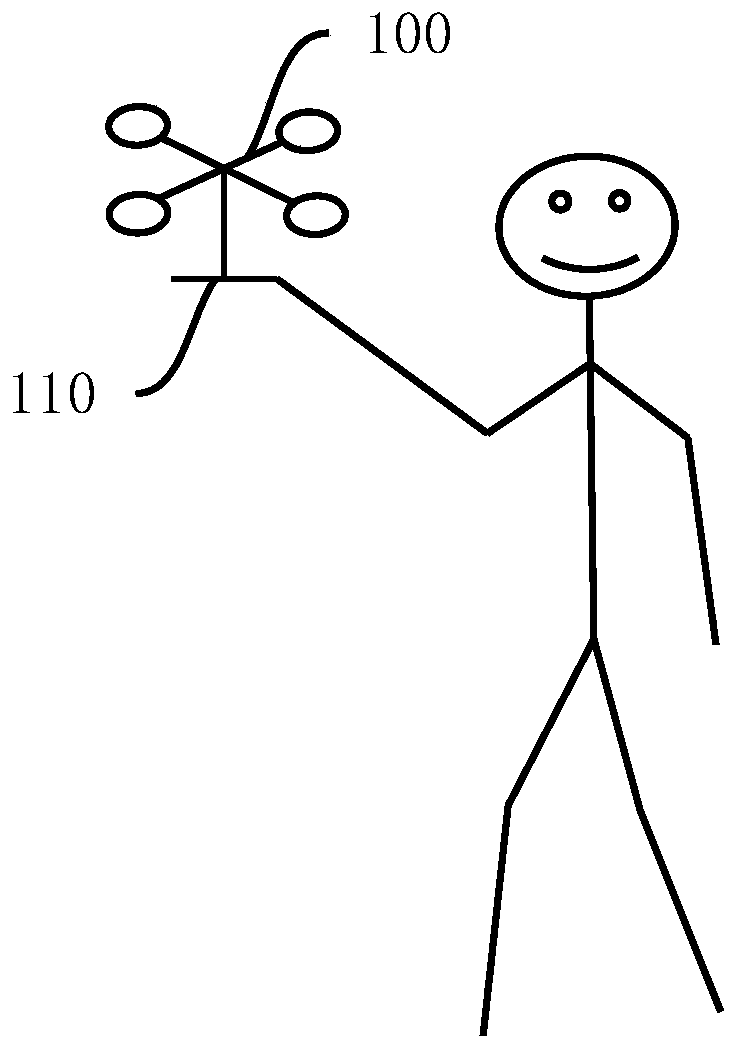Unmanned aerial vehicle, unmanned aerial vehicle take-off control method and device
A control method and unmanned aerial vehicle technology, which is applied in the field of unmanned aerial vehicles, can solve the problems that unmanned aerial vehicles have a single take-off mode, cannot automatically select the take-off mode and automatically take off, etc.
- Summary
- Abstract
- Description
- Claims
- Application Information
AI Technical Summary
Problems solved by technology
Method used
Image
Examples
no. 1 example
[0042] This embodiment provides a UAV take-off control method for controlling the UAV 100. The method can select different take-off platforms corresponding to the take-off platform 110 according to the different take-off platforms 110 where the UAV 100 is located. Way.
[0043] Specifically, see Figure 4 , the method includes:
[0044] Step S110: Obtain the state parameters of the UAV when the take-off preparation signal is received.
[0045] First, the processor 103 of the UAV 100 receives the take-off preparation signal, and, if it is determined that the take-off preparation signal is received, acquires the state parameters of the UAV.
[0046] In this embodiment, the take-off preparation signal may be converted from the take-off preparation instruction received by the UAV 100 and sent by the user. When the unmanned aerial vehicle 100 needs to take off, the unmanned aerial vehicle 100 is placed on the take-off platform 110 where it is desired to take off. When a mobile ...
Embodiment approach
[0136] Step S1334: The movement speed of the UAV 100 in each sampling time period within the first predetermined delay time range is equal to or greater than the first speed threshold, and it is determined that when the first predetermined delay time ends After the take-off ends, the UAV 100 is controlled to hover at the height at which the UAV 100 is at the end of the take-off.
[0137] If within the first predetermined delay time range, the rotation speed adjustment after accelerating the rotor speed to the rated speed has not caused the UAV 100 to reach the hovering state, then it is determined that the UAV is at the end of the first predetermined delay time. 100 take-off ends, record the height at which the drone 100 is at the end of the take-off. Finally, the UAV 100 is controlled to hover at the height of the UAV 100 at the end of the recorded take-off. For example, when the take-off ends, the height of the UAV 100 is 4m. When the current height of the UAV 100 is greate...
no. 2 example
[0159] This embodiment provides a drone take-off control device 200 for controlling the drone 100, please refer to Figure 15 , the device 200 includes:
[0160] The parameter acquisition module 210 is used to obtain the state parameters of the unmanned aerial vehicle under the condition of receiving the take-off preparation signal; the take-off mode determination module 220 is used to determine the take-off mode of the unmanned aerial vehicle 100 according to the state parameters of the unmanned aerial vehicle 100; The control module 230 is configured to control the UAV 100 to take off in a determined takeoff manner.
[0161] Specifically, the take-off signal receiving module 210 may be used to receive a take-off preparation signal input through a remote control device, a button, the image acquisition device 107, a voice control sensor or an acceleration sensor.
[0162] Furthermore, in this embodiment, the flight control module 230 may control the UAV 100 to take off in a d...
PUM
 Login to View More
Login to View More Abstract
Description
Claims
Application Information
 Login to View More
Login to View More - R&D
- Intellectual Property
- Life Sciences
- Materials
- Tech Scout
- Unparalleled Data Quality
- Higher Quality Content
- 60% Fewer Hallucinations
Browse by: Latest US Patents, China's latest patents, Technical Efficacy Thesaurus, Application Domain, Technology Topic, Popular Technical Reports.
© 2025 PatSnap. All rights reserved.Legal|Privacy policy|Modern Slavery Act Transparency Statement|Sitemap|About US| Contact US: help@patsnap.com



